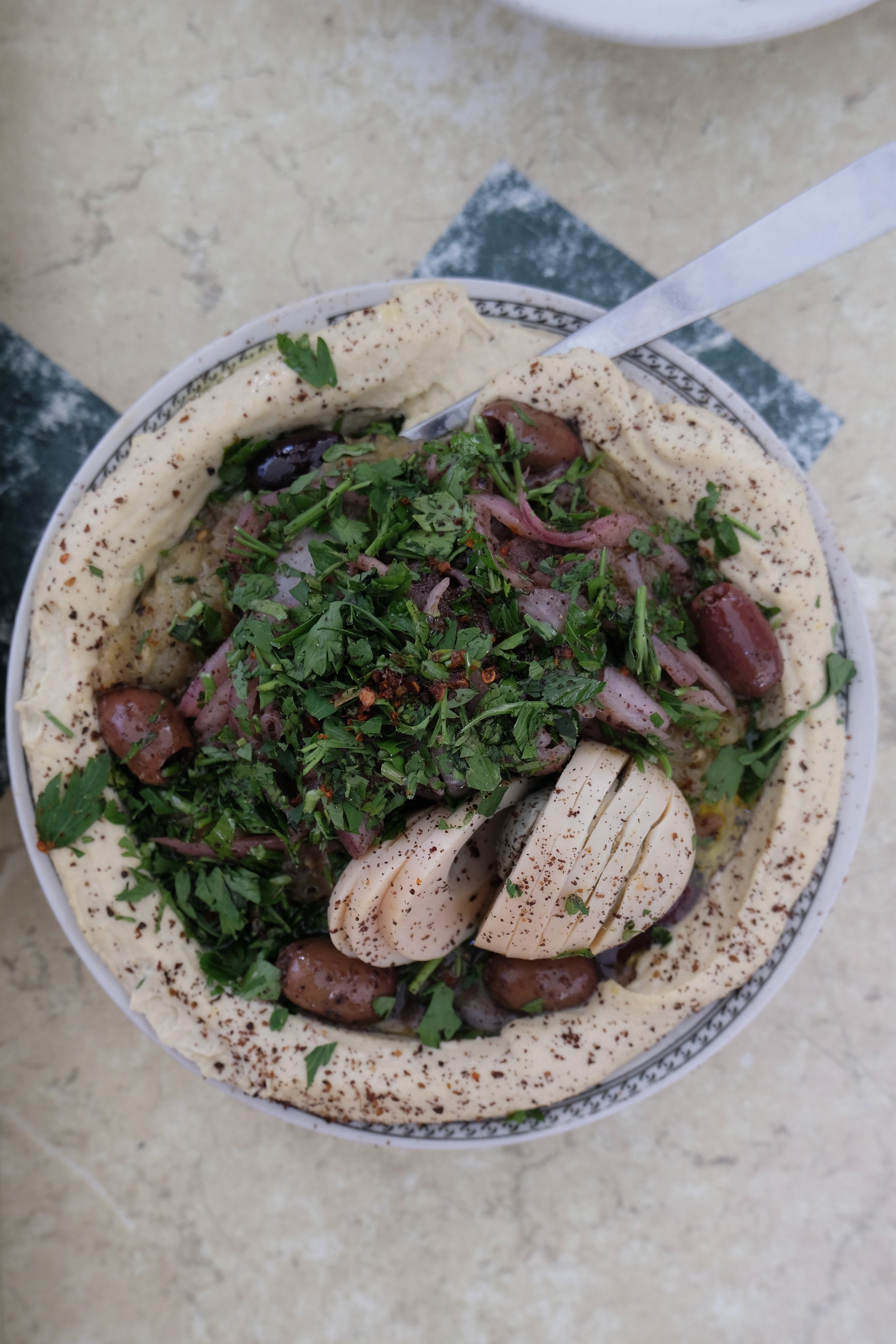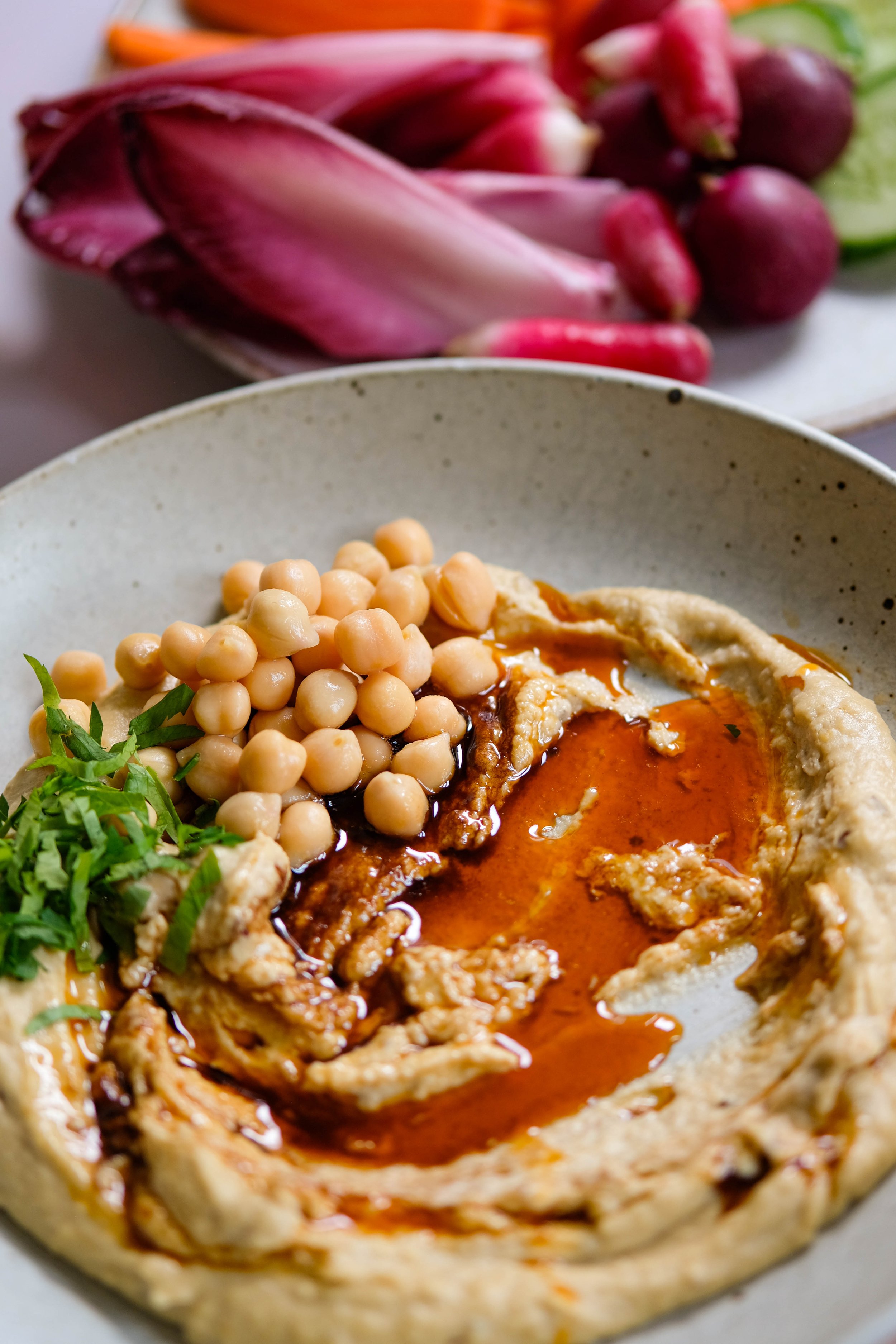What Israel taught me about hummus
In September 2022 I went to the Holy Land with my half-Israeli boyfriend.
It turns out, I’ve been eating hummus wrong. (Thank you, Hinge, for this piece of gastronomic education).
It’s a main meal, not a spread or a side. To be eaten in copious quantities and piled high with a variety of toppings.
The key to making your own hummus is taking the time to soak and cook your own chickpeas. It is the only way to achieve the desired smoothness and creaminess.
Please stay away from cans. Some people say skinning a can of chickpeas results in a creamy hummus but I say you are kidding yourself if you feel this very marginal improvement is worth the time spent peeling tiny legumes. If you want a quick and easy hummus, buy some. To make it, you really must soak and cook.
The Israelis use hummus as a vehicle for toppings. Served with fresh pitta breads and veggie sticks for dipping, they pile it high with roasted aubergine, spiced, minced beef or some sliced hard-boiled eggs. (As an egg lover and person who is often hungry I found this high-protein combination particularly pleasing).
Some things to bear in mind :
Using garlic powder rather than fresh garlic yields a milder flavour. No acrid sting, no allium breath.
The simpler the dish, the more the ingredients speak, so make sure they’re good quality. Get some fresh cumin and coriander seed, not a jar that’s been in your cupboard for ages. Extra virgin olive oil. A good quality tahini is key. Some brands I would recommend in the UK are Belazu or Med Cuisine.
The ratio of tahini to chickpeas is about 30% / 70%. The tahini is mixed with spices and lemon juice, and then that mix is blended through the cooked chickpeas. Fat carries flavour, so take your time with this step to make sure it’s really delicious.
Olive oil goes on, not in. Tahini has enough fat to emulsify the spread, and a drizzle of good quality extra virgin olive oil on top will finish off your hummus.
Garnish is key. It doesn’t need to be fancy, but if you are already taking the time to make your own hummus, why not lean in and present it nicely. Spread the hummus out flat onto a serving plate. Smooth out some indentations with a spoon and drizzle with olive oil, sprinkle with spices, flaky sea salt and black pepper, and top with some reserved, whole chickpeas.
Here is an approximate recipe. The key to hummus, (the key to a lot of cooking) is to taste as you go, use your instincts and make the hummus you want. Is it smooth and creamy enough for you, do you want more salt, less lemon, etc, etc. Trust yourself.
Ingredients
175g dried chickpeas
100g good quality tahini
juice of 1 lemon
1/2 – 1 teaspoon garlic powder
1/2 – 1 teaspoon ground cumin
1/2 – 1 teaspoon ground coriander
flaky sea salt
good quality extra virgin olive oil
Left - a plate of hummus with boiled eggs and olives in Tel Aviv
Right - a plate of hummus in my kitchen
Directions:
Place the chickpeas in a large bowl. Cover them with water by 2-3 inches, bearing in mind that they will triple in size as they soak. Leave to soak overnight or for at least eight hours.
Drain the chickpeas, place them in a saucepan and cover with fresh water. Place over a medium-high heat and bring to a simmer. Allow to cook for 45 minutes – 1 hour, until seriously tender. The skins should be coming off and they should be beginning to disintegrate. Then drain well and spread out onto a large plate or baking tray. You want them to cool in a single layer, or close enough, to ensure an even texture.
While the chickpeas are cooking make your tahini. Place the tahini in a bowl and whisk together with the lemon juice, spices, salt and 4-5 tablespoons of water until you have a runny mixture. It should taste strong and punchy, it will mellow out considerably once blended with the chickpeas.
Place the cooked chickpeas and tahini mixture into a blender or food processor, reserving a small amount of cooked chickpeas for garnish. Blend until smooth and creamy, adjusting the seasoning to suit your taste.
Spread the tahini out in a serving bowl, drizzle with good quality olive oil, top with the reserved chickpeas and a sprinkle of spices and flaky sea salt.
If not using straight away, hummus keeps in the refrigerator for up to five days. It also freezes well.

